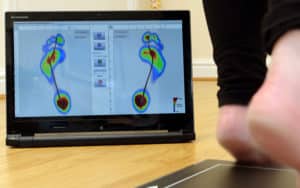“Uh Oh! I’m doing the Great North Run in September and I’ve got a pain!
What shall I do?!”
In September, tens of thousands of people will be taking to the streets of Newcastle to participate in the Great North Run. For many this will have meant months of preparation, building up the miles, finding the right trainers and getting the sponsorship.
But what do you do if, so close to the race, you start to feel a niggle? Maybe 3 miles into an 8 mile run, maybe when you wake up in the morning. Be it in your calf or your quads, your knee or hip, ankle or back, something doesn’t feel quite right.
Don’t panic!
First of all, do not panic. A niggle is not always an indication of a serious injury on its way. Signs of a severe injury would be intense pain, swelling, redness or bruising. If these are present use the PRICE (Protect, Rest, Ice, Compression, Elevation) technique. Rest from running for 48 hours but continue with some active movements of the affected area. Then gradually return to gentle jogging and progress as pain allows. If the pain and/or swelling returns, seek professional advice.
If these acute signs aren’t present, it may be that there is an area of your body that is being over-loaded. Try adapting your running style. Shorten or lengthen your stride, increase or decrease your speed, try a foot-flat technique. This will alter the strain on the over-loaded areas. Alternatively consider your training pattern.
Have you increased your intensity and/or distance too quickly?
Have you been giving yourself enough recovery time between runs?
Are you hydrating adequately and having the correct diet?
Have you introduced hills or speed training? Are you feeling “under the weather”, suffering from hay fever or a cold?
If so, you need to consider this and adapt your training programme accordingly by shortening your distance or having recovery periods during your run – slowing down or even walking.
Once you have considered all of the above and the pain deceases or even is abolished, then this is a good sign and you can continue building up your training. If the pain doesn’t abate or it worsens, get in touch with us.
How do I return to my training programme?
The best method to decide whether to continue running with pain is to score it. Use a score known as the Verbal Rating Scale (VRS) of 0 -10 where 0 is no pain at all and 10 is the worst pain you could possibly imagine. A score of 5 or above that doesn’t decrease by altering your running pattern or training regimen would suggest you should stop and seek professional advice.
If those signs of a severe injury aren’t present and the pain begins to settle, then start gradually loading the limb again.
Try a short run initially. Ensure the distance is dependent on how far you were running at the time the pain came on.
Run over easy terrain and gradually increase the load (distance, speed or inclines).
Continually assess your pain and alter your training accordingly.
Ensure a good recovery following your run – hydrate, stretch and use baths to help prevent the build-up of lactic acid.
What about the use of tape?

If you feel you can continue your training through your niggle you may choose to protect the affected area by using tape to off-load it and encourage improved muscular control around the area. Various taping techniques can be found on You Tube or seek advice. Never use tape if you have an allergy to adhesive and if your skin reacts with itching, redness or burning then remove the tape immediately.For specific taping advice, get in touch.
What about my footwear?

One thing not be recommended this close to the event is to change your running shoes. This could adapt not only your foot posture but all the way up the chain. We have a gait scanner at the clinic which can help advise you on foot posture and running shoes for future events as well as individual strengthening and flexibility exercises you may benefit from. Believe it or not, tightness in your hip flexors can result in incorrect landing on your foot and foot pain.
Painkillers or not? Paracetamol or anti-inflammatories?!
You may decide to take anti-inflammatories or pain killers such as paracetamol. Some people would rather not as they are concerned it will cover the signs of severe injury, but they will never mask the signs of a severe injury. There has been some research to suggest the use of anti-inflammatories in the first 24 – 48 hours of a muscle injury could delay healing. Paracetamol is a very effective medication with minimal side effects and could allow you to continue to function.
So, should I continue with the Great North Run?!
The decision as to whether to risk delaying recovery to participate in the run is, in the end, yours. If signs of a severe injury are present, then you are at risk of causing further issues and advice should be sought. Some people will undoubtedly decide, given all their training, to push through niggles, but if in doubt, please give us a call or email us.
Dallas has run several marathons and endurance events in the past and I have participated (at a very slow pace!) in a couple of half marathons, including the Redcar Half Marathon last October. So not only do we have the theory but the practical experience and empathy as well!
Finally, we’d like to wish all those running on September the 10th the very best of luck. You never know, maybe we’ll join you next year!
Kate Bye
